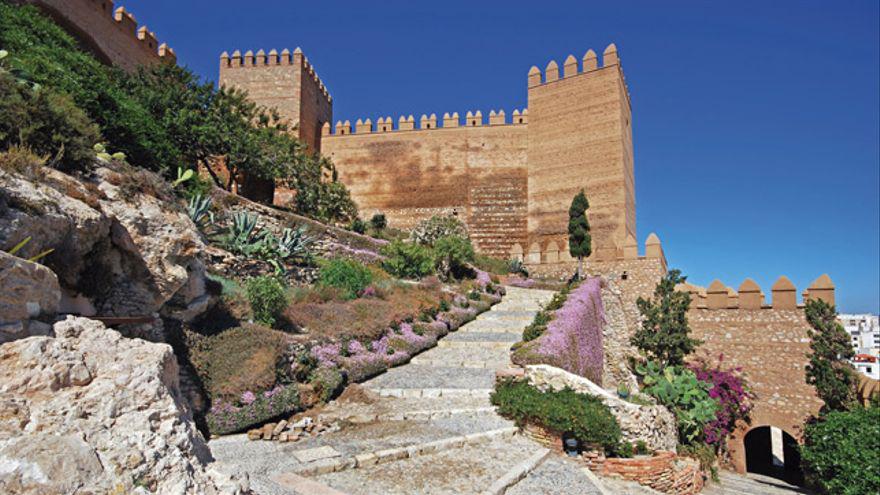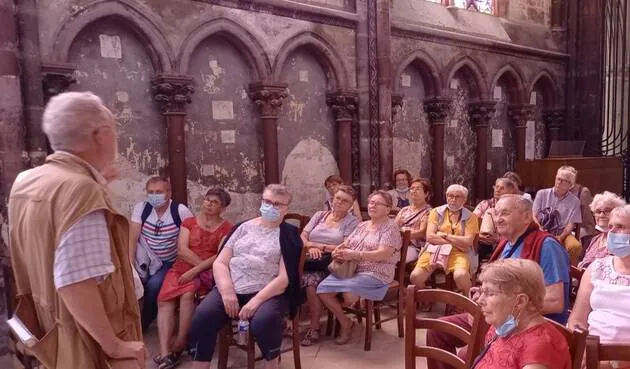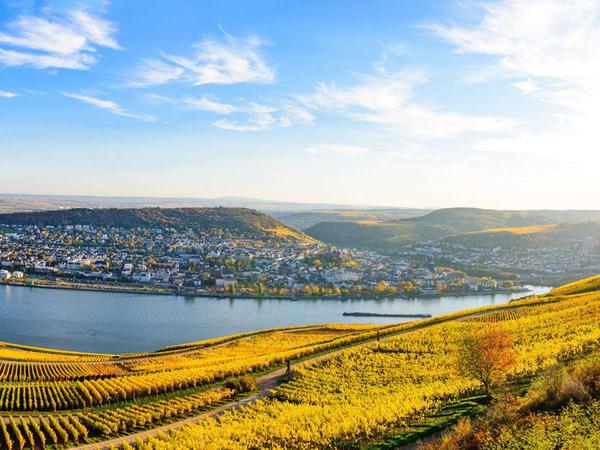Almería, the perfect province to travel by car on a winter getaway
In the southeast corner of the peninsula, a province as geographically variable as Almería is angled, where you can find the Cabo de Gata Natural Park and its coves as well as the Tabernas desert; or with white towns with history and prehistoric or unique caves such as the Geoda de Pulpí, recently opened to the public. In addition, given its privileged climate, it is perfect for a car getaway throughout the year.
We propose an itinerary that begins in the capital, Almería, and runs through Sorbas, Vera, Vélez-Rubio, Vélez Blanco, Huércal - Overa, Macael, Serón, the Tabernas desert, Roquetas de Mar, Adra, El Ejido and Almerimar.
Starting the route through Almería capital, whose main attraction is, without a doubt, the Alcazaba, the Andalusian fortress over a millennium old, which watched over the Gádor and Alhamilla mountains from the top of the Cerro de San Cristóbal. A Site of Cultural Interest (BIC), the architectural complex houses a castle and several towers from the late medieval Christian period, whose greatest exponent is the Cathedral of the Incarnation, the only one with the nature of a fortress built in 16th-century Spain.
More laymen are the English Cable, a port mineral loading dock; the Arab Cisterns of Jairán, from the 11th century; the Faluca Almariya, a replica of a Spanish-Muslim ship; and the Civil War air-raid shelter recovered by the City Council. At lunchtime, enjoy your choice of a free tapa from a wide variety of blackboards in the bars of Plaza Vieja, the popular neighborhood of La Chanca and Parque Nicolás Salmerón.
Sorbas, a very picturesque town
About 60 kilometers from Almería by car on the A-7, lies the picturesque and photogenic town of Sorbas, founded by the Arabs in the 11th century, also popularly called "Cuenca chica", because its houses hang over the 'Afa ravine. '. You will be delighted with the different perspectives of the town and its surroundings from viewpoints such as the Porch, the Castle, the Calvario and the Torreta. Take the opportunity while strolling through its historic center and the Potteries neighborhood to buy some ceramic souvenirs, before recharging your batteries by trying local recipes such as ajoblanco, vegetable stew, gurullos with rabbit, migas and porridge.
The Visitor Center "Los Yesares" is an obligatory stop prior to the "Karst en Yesos de Sorbas" Nature Reserve, one of the planet's geological jewels made up of caves, canyons, sinkholes, geodes and other karstic formations excavated in the plaster by erosion. of rain over six million years.
Vera is 40 kilometers away, the quintessential nudist town in Spain, with its immense beaches of Puerto Rey, Las Marinas and El Playazo, its white and flowery houses, its hermitages of the Virgen de las Angustias and Las Huertas, San Ramón, the Holy Spirit… The Plaza Mayor of the old town houses the Fortress Church of Our Lady of the Incarnation, the Town Hall and the Ethnographic Museum of Vera. And from the Mirador, crowned by an image of the Sacred Heart of Jesus, fantastic views of the valley and the coast of the Alboran Sea are contemplated.
We continue the route 6 kilometers from Vera, where the town of Cuevas del Almanzora stands, whose historical mines have allowed the accumulation of a rich monumental heritage such as its beautiful buildings, churches such as Nuestra Señora de la Encarnación or San Sebastián, and the Castle of the Marquis de los Vélez

The largest geode in Europe and the second in the world
We take the car again to reach the Cuevas de Calguerín, some 300 caves that were shelters and dwellings during medieval times... and still today.
But nothing to do with the Pulpí Geode, also called the Pilar de Jaravía Geode, 25 km away. The largest geode in Europe and the second in the world, and the only one that can be visited since this year, despite the fact that it was discovered in 1999. Imagine the look on its discoverers' faces when they saw that rocky cavity covered with beautiful gypsum crystals, some of them almost two meters.
Crossing the wild mountains and pine and holm oak forests of the Sierra María-Los Vélez Natural Park, you reach Vélez-Rubio, perched on a hill and with an old quarter with architectural styles from the 18th and 19th centuries. It is a Site of Cultural Interest due to buildings such as the Church of Our Lady of the Incarnation, the Church of Our Lady of Carmen and various stately mansions and modernist homes. In its restaurants you can try ajo colorao, a stew with corn balls and longaniza and gurullos, stews with flour masses with partridge or rabbit.
The next visit is the Cueva de los Letreros, a complex of caves with valuable Levantine rock art from about 5,000 years ago and declared a World Heritage Site by UNESCO, among other wonders, by the Indalo, that little man that you will see everywhere with the rainbow in his hands.
The other town of the Vélez is Vélez Blanco, with its Monumental Enclave of the Castillo de Vélez-Blanco or Los Fajardo, with its fortress and a palace presided over by a keep built in the 16th century in Renaissance style with late Gothic elements. and the Mudejar. You cannot miss the Church of Santiago and the Convent of San Luis.
Huercal-Overa, Macael and Seron
In Huércal-Overa you will be surprised by the fertile orchards that color an eminently semi-desert environment of arid hills and its three Assets of Cultural Interest: the Castle of Huércal-Overa, the Parish of Our Lady of the Assumption and the Castle of Santa Bárbara, a defensive watchtower built in the 13th century by the Nasrid Kingdom.
Crossing the Almanzora valley will lead you to Macael on a memorable journey parallel to the Almanzora River that fills the canvas with blooming almond trees, orange trees and orchards in brutal contrast with the marble of the Sierra Blanca de los Filabres, which presides over the valley and justifies that Macael is called the "capital of White Gold". That white marble is only found in every corner of the city, for example, in the world's largest Mortar, a piece of 50,000 kilos.
You have to go to Serón, even if it is to eat ham, although you have to see the 13th century Nasrid castle and the Parish of Our Lady of the Annunciation, before continuing to the mining town of Las Menas and towards the Calar Alto Observatory , high because it stands at 2,168 meters high, the largest astronomical observatory in all of Europe. From there, you cross the amazing desert of Tabernas, the only desert region on the European continent, almost Africa, which hits like the western of the movies for its cacti, reddish rocks and bizarre formations.
Roquetas de Mar, Adra, El Ejido and Almerimar, the last stops
You will be shocked to go directly to the Punta Entinas-Sabinar Nature Reserve, a landscape of dunes, beaches and lagoons of great beauty among which Roquetas de Mar suddenly appears, which not because it is more touristy lacks wild beaches and difficult access like the one in Cerrillos or restaurants with a Michelin star like Alejandro. You can visit the Castillo de Santa Ana or de las Roquetas, its Roquetas lighthouse from 1863; the Church of Nuestra Señora del Rosario, in Mudejar and Baroque styles from the mid-18th century; and the watchtower of Cerrillos.
50 km away is Adra, in the foothills of the Sierra de la Contraviesa and with 20 kilometers of coastline, with beaches such as La Caracola, between the ravines of Fuente Ahijado and Bolaños, Sirena Loca and El Carboncillo. It also has the Natural Reserve of Las Albuferas de Adra, an important sighting point for migratory waterfowl, in contrast to the sea of greenhouses that employ the local population.
Thanks to its activity, El Ejido is rich and that is why it is a good cultural epicenter, but it also stands out with the Daimún funerary monument, the Ciavieja archaeological zone, declared an Asset of Cultural Interest; the Fortified Tower, located in the town of Balermo, the castle of Guardias Viejas...
To the south of El Ejido, the most touristic is Almerimar or Ensenada San Miguel, a quiet town straddling the Sierra de Gádor and the Mediterranean Sea, with a golf course, marina and the nearby Mar de Alborán Natural Park. If you let yourself, they will break your prejudices about greenhouse agriculture at Clisol Agro, just before offering you a tasting of different varieties of tomato, cucumber and pepper with extra virgin olive oil, bread and honey, fried, jam and mousse. of vegetables.


